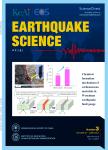High-velocity frictional behavior of Longmenshan fault gouge from Hongkou outcrop and its implications for dynamic weakening of fault during the 2008 Wenchuan earthquake
High-velocity frictional behavior of Longmenshan fault gouge from Hongkou outcrop and its implications for dynamic weakening of fault during the 2008 Wenchuan earthquake作者机构:Department of Earth and Planetary Systems Science Graduate School of Science Hiroshima University Higashi-Hiroshima 739-8526 Japan State Key Laboratory of Earthquake Dynamics Institute of Geology China Earthquake Administration Beijing 100029 China Kochi Institute for Core Sample Research Japan Agency for Marine-Earth Science and Technology ( JAMSTEC) 200 Monobe-otsu Kochi 783-8502 Japan
出 版 物:《Earthquake Science》 (地震学报(英文版))
年 卷 期:2011年第24卷第3期
页 面:267-281页
核心收录:
学科分类:070801[理学-固体地球物理学] 07[理学] 0708[理学-地球物理学]
基 金:supported by State Key Laboratory of Earthquake Dynamics (project No.LED2008A03) Wenchuan Earthquake Fault Scientific Drilling Project(WFSD),by a Grant-in-Aid for JSPS fellows to the first author (T.Togo) and a Grant-in-Aid for young scientists(B) 201007605,and by a 2009 FGI Grant-in-Aid of Fukada Geological Institute
主 题:Wenchuan earthquake high-velocity friction fault mechanics Longmenshan fault system Beichuan fault
摘 要:High-velocity friction experiments were conducted on clayey fault gouge collected from Hongkou outcrop of Beichuan fault, located at the southwestern part of Longmenshan fault system that caused the disastrous 2008 Wenchuan earthquake. The ultimate purpose of this study is to reproduce this earthquake by modeling based on measured frictional properties. Dry gouge of about 1 mm in thickness was deformed dry at slip rates of 0.01 to 1.3 m/s and at normal stresses of 0.61 to 3.04 MPa, using a rotary-shear high-velocity frictional testing machine. The gouge displays slip weakening behavior as initial peak friction decays towards steady-state values after a given displacement. Both peak friction and steady-state friction remain high at slow slip rates are exam- ined and gouge only exhibits dramatic weakening at high slip rates, with steady-state friction coefficient values of about 0.1 to 0.2. Specific fracture energy ranges from 1 to 4 MN/m in our results and this is of the same order as seismically determined values. Low friction coefficients measured on experimental faults are in broad agree- ment with lack of thermal anomaly observed from temperature measurements in WFSD-1 drill hole (Wenchuan Earthquake Fault Scientific Drilling Project), which can be explained by even smaller friction coefficient for the Wenchuan earthquake fault. High-velocity friction experiments with pore water needs to be done to see if even smaller friction is attained or not. Shiny slickenside surfaces form at high slip rates, but not at slow slip rates. Slip zone with slickenside surface changes its color to dark brown and forms duplex-like microstructures, which are similar to those microstructures found in the fault gouges from the Hongkou outcrop. Detailed comparisons between experimentally deformed gouge samples and WFSD drill cores in the future will reveal how much we could reproduce the dynamic weakening processes in operation in fault zones during Wenchuan earthquake at present.



